Effective Techniques for a Whiter Bathtub
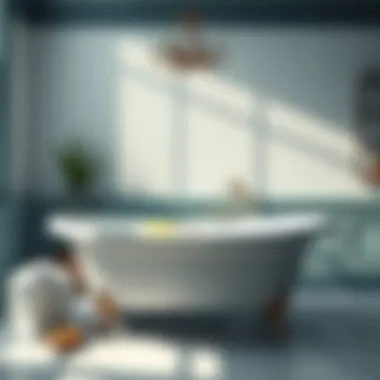
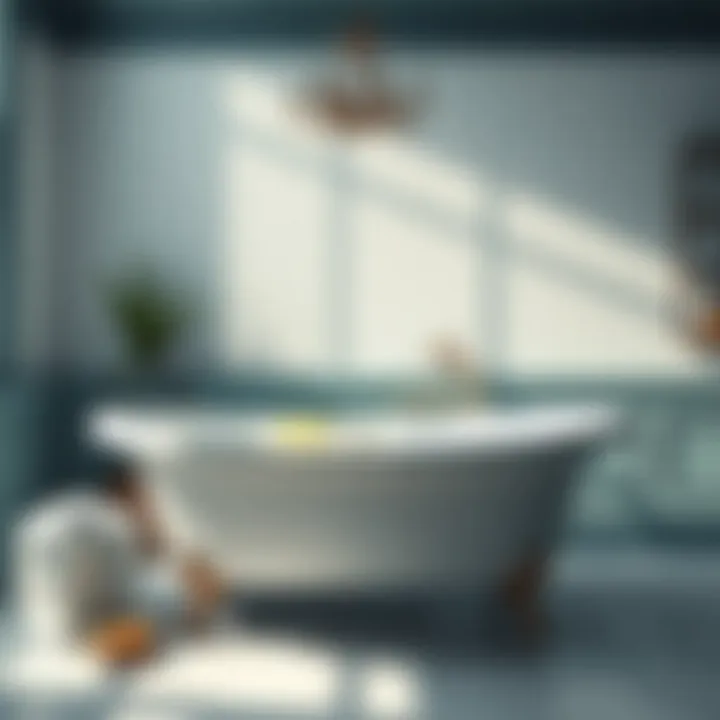
Intro
Creating a pristine bathing space is not just a matter of aesthetics; it’s about experiencing a clean, refreshing retreat within the home. Over time, bathtubs can lose their luster, tarnished by grime, soap scum, and hard water stains. Therefore, understanding how to effectively restore and maintain this essential element of the bathroom is crucial for all homeowners and housewives alike. This article presents a comprehensive guide, delving into practical insights and effective techniques for achieving a whiter bathtub, suitable for a variety of materials and conditions.
Moreover, we will emphasize sustainable solutions that not only enhance the appearance of your bathtub but also align with environmentally-friendly practices. Whether you’re equipped with a toolbox full of DIY solutions or considering commercial cleaning products, there’s something valuable to glean here. Let's embark on this journey toward a bright, clean bathtub that invites relaxation and comfort.
Current Trends
In today’s home improvement landscape, bathtub aesthetics has shifted, reflecting broader trends in interior design. Understanding where the aesthetic joy lies taps into the heart of homeowner priorities.
Color Palettes
Currently, soft pastels and bold monochromatic contrasts are gaining traction. While the classic white tub remains timeless, shades like pale blue, mint green, and even deep navy are emerging. These colors not only enhance the overall ambiance of a bathroom but also make stains and discoloration more noticeable.
Finding the right color palette can impact how often one needs to clean and maintain the bathtub. After all, opting for relaxed hues can magnify signs of aging quicker than a crisp white surface.
Popular Styles
The shift to minimalistic designs has resulted in sleek, streamlined bathtubs that require specific cleaning methods. Free-standing tubs, for example, are all the rage, but they come with their own set of care protocols. It’s crucial to consider the material; acrylic, cast iron, or fiberglass – all demand distinct approaches to maintain their whiteness. Keeping these style trends in mind is an essential part of maintaining your bathtub's aesthetic appeal.
Visual Ideas
Visual inspiration can serve as a strong catalyst for improvement. Having a clear idea of transformative possibilities helps drive progress.
Gallery of Styled Bathrooms
A collection of styled bathroom images is a great way to understand the impact that design choices can have. Imagery showcasing both modern and traditional settings can ignite creativity and help imagine how a whiter bathtub can fit within various styles. Websites such as Pinterest or Houzz offer numerous options for viewing various bathroom layouts that work beautifully with clean, bright tubs.
Before-and-After Transformations
Witnessing the dramatic difference a good cleaning or refinishing treatment can make fosters motivation. Before-and-after transformations can inspire homeowners to tackle their own tub cleaning efforts. A simple search on social media platforms or dedicated home improvement blogs can lead you to striking visual case studies, offering proof that success is achievable when the right strategies are employed.
“Cleaning isn’t just a necessity; it’s an art form that can elevate the everyday bathroom experience.”
Understanding Bathtub Materials
Understanding the various materials used in bathtubs is fundamental to achieving that coveted white finish. Each material possesses its own unique properties, cleaning requirements, and susceptibility to stains. Knowing what you’re working with helps in selecting the right cleaning strategies and products, ensuring that you can maintain both the aesthetics and functionality of your bath space. Let's delve deeper into the specifics of each material, as this knowledge lays the groundwork for effective cleaning.
Acrylic Bathtubs
Acrylic bathtubs are known for their lightweight and warm-to-the-touch surfaces. They come in diverse shapes and sizes, making them a popular choice among homeowners. One major advantage is their resistance to chipping and scratching. When it comes to cleaning, regular maintenance can do wonders. A simple solution of warm water and mild soap often suffices. However, it’s crucial to avoid abrasive cleaners, as these can mar the glossy finish, leading to a dull appearance over time.
Fiberglass Bathtubs
Fiberglass bathtubs are appreciated for their affordability and ease of installation. They are typically coated with a gel finish that can begin to yellow and lose its sheen if not cared for properly. To keep these bathtubs looking their best, a gentle scrub with a soft-bristle brush and a blend of vinegar and baking soda can help lift stains without damaging the surface. The flexibility of fiberglass is an attractive feature, but it does mean that more delicate handling is required during cleaning to avoid scratches.
Porcelain Enamel Bathtubs
Porcelain enamel bathtubs, made from cast iron or steel coated with porcelain enamel, boast a classic look and exceptional durability. Their surface is harder than acrylic or fiberglass, which affords some resistance to scratches. Nevertheless, they can be prone to chipping if subjected to heavy impacts. For cleaning these bathtubs, a mixture of baking soda and water can efficiently tackle soap scum and stains. Be mindful, though — harsh chemicals can damage the glaze, leading to future stains and discoloration.
Cast Iron Bathtubs
Cast iron bathtubs are the heavyweight champions in the world of bathrooms. Their substantial build gives them a sense of permanence and luxury. When properly maintained, they can last a lifetime. However, this durability comes at a price when it comes to cleaning: the enamel finish can wear down, exposing the iron underlayer to rust. To prevent this, it's essential to use non-abrasive cleaning solutions and to dry the tub thoroughly after each use. An occasional wax treatment can not only enhance its shine but also provide a layer of protection against stains and moisture.
Key Point: Knowing the type of bathtub material in your bathroom is essential for selecting the correct cleaning methods and products. Each material requires different strategies to maintain its whiteness and overall appearance.
Identifying Common Stains and Discoloration
When it comes to keeping your bathtub looking pristine, knowing your enemy is half the battle. Understanding the various stains and discolorations that plague bathtubs is essential. Not only does this knowledge allow for more effective cleaning strategies, but it also helps in selecting the right products and techniques for different material types. Neglecting to identify these common issues can lead to deeper stains and damage, ultimately making treatment more complicated and costly.


Hard Water Stains
Hard water stains are a common nuisance in many households. These stains are caused by minerals, particularly calcium and magnesium, found in tap water. When water evaporates, it leaves behind these minerals, forming unsightly spots on the bathtub surface.
It's crucial to address these stains quickly. If left unchecked, the deposits can become harder to remove over time, leading to etched surfaces that trap more dirt and grime. To combat hard water stains effectively, periodic cleaning with a mixture of vinegar and water can be beneficial. The acid in vinegar helps to break down the mineral deposits, leaving your tub much cleaner after multiple uses.
Soap Scum Build-Up
Soap scum is the sticky residue that builds up over time from the combination of soap, body oils, and hard water. This build-up is not only unattractive but creates a slippery surface that can pose safety risks. Identifying soap scum should be at the top of your cleaning agenda, as it can also trap bacteria and mold, leading to unhygienic conditions.
For effective removal, it’s best to use a non-abrasive cleaner specifically designed for your bathtub material. Many prefer to create a solution using baking soda and white vinegar, which can help dissolve the soap scum while being gentle on the surface. A simple scrub with a soft-bristled brush can then work wonders in restoring your tub’s shine.
Mold and Mildew
Mold and mildew thrive in moist environments, making bathtubs an inviting habitat. They not only contribute to an unpleasant odor but can also lead to health concerns, particularly for individuals with respiratory issues. It’s pivotal to recognize the first signs of mold and mildew, which often present as black or green patches.
Preventive measures are key here. Regular cleaning and ensuring proper ventilation after bathing can make a significant difference in keeping mold at bay. When it does appear, a mix of hydrogen peroxide and water can be effective for battling these fungi. Additionally, don’t forget to keep the areas around the tub dry to prevent recurrence.
Rust Stains
Rust stains are particularly notorious in older homes where cast iron or metal fixtures are present. When water containing iron comes into contact with the tub surface, it can leave behind orange or reddish-brown marks. Besides affecting the visual appeal, rust can lead to structural damage if not dealt with promptly.
To treat rust stains effectively, products with oxalic acid can be used, as they are formulated to dissolve rust. However, you’ll want to apply these as per the product’s directions, ensuring that they do not damage the surrounding material. Frequent checks for rust, especially if you notice discoloration, can save you from severe problems down the road.
Identifying the types of stains and discoloration is essential in maintaining that clean, inviting aesthetic of your bathtub. The right approach varies from substance to substance, making it necessary to understand each one well.
Cleaning Techniques for Whiter Bathtubs
Cleaning your bathtub doesn’t just make it look good; it’s vital for prolonging its lifespan. Different bathtubs require their cleaning methods, depending on the materials and types of stains present. A thorough cleaning routine not only enhances the hygiene of your bathing environment but also prevents the buildup of stubborn grime, which could lead to more significant repair issues down the line.
Natural Cleaning Solutions
These solutions are eco-friendly, often affordable, and easily accessible.
Vinegar and Baking Soda
Combining vinegar and baking soda is like striking gold in the realm of natural cleaning. This duo creates a fizzy reaction that helps lift dirt and grime. The acetic acid in vinegar breaks down mineral deposits and grease, while baking soda adds that gentle abrasive quality needed for scrubbing away tough stains.
This method is favored for being non-toxic, making it safe for families and pets. A common approach is to sprinkle baking soda in the tub, spray vinegar, and let it sit for 15 minutes before scrubbing. However, one must ensure not to use this method on sensitive surfaces.
Lemon Juice and Salt
Lemon juice and salt is another great option for tackling stains. Lemon juice is a natural bleaching agent, while salt operates as an exfoliant. The acidity of the lemon helps break down oxidation and stains, giving your bathtub a fresh smell too.
This natural solution shines particularly when addressing build-up around the faucet or drains. Just mix the two into a paste, apply it to the affected areas, and scrub. However, lemon juice can potentially lighten colored surfaces, so be cautious!
Hydrogen Peroxide
Hydrogen peroxide is also a remarkable cleaning agent. It acts as a disinfectant, helping to eliminate bacteria and fungi, making it suitable for areas with mold or mildew. This method often comes into play when more severe discolorations appear.
Utilizing hydrogen peroxide is as simple as pouring it into a spray bottle and applying it directly onto the stains. Let it sit for about 30 minutes before rinsing. Notably, while it’s effective, it may not be a good idea for colored bathtubs, as it can cause fading over time.
Commercial Cleaning Products
On the other hand, many people opt for commercial cleaning products for immediate tough stain solutions. Each category has its strengths and limitations.
Bleach-Based Cleaners
Bleach-based cleaners are effective in tackling severe mold and mildew issues. They offer instant results in whitening, especially on porcelain surfaces. This strong chemical is particularly good at eliminating odors and disinfecting.
However, bleach has a harsh scent and can discolor certain materials. It’s crucial to ventilate the area when using them and follow all safety instructions to avoid any mishaps.
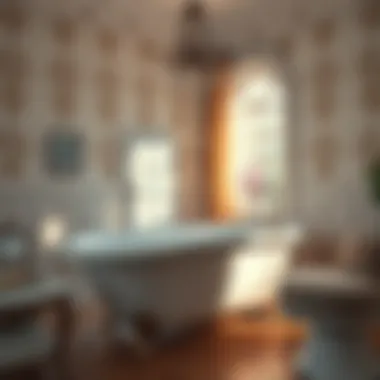
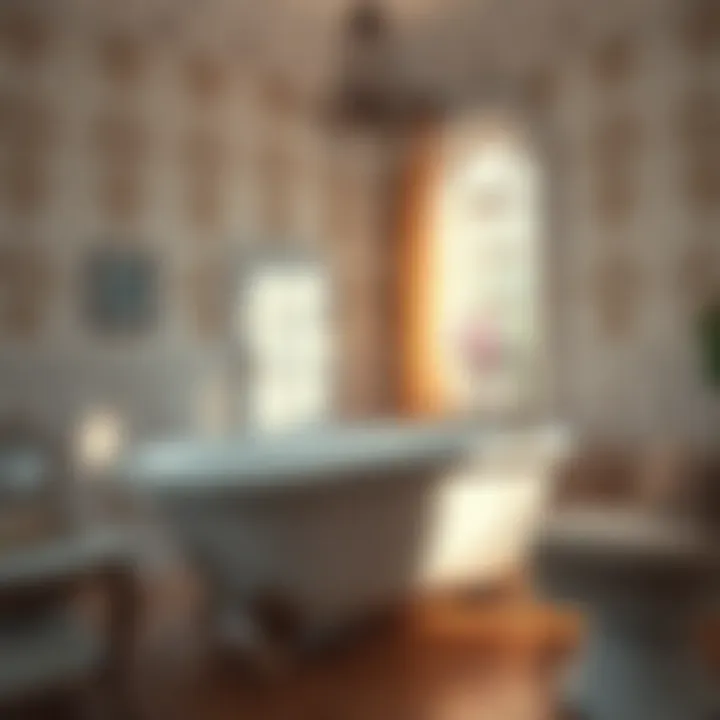
Acidic Cleaners
Acidic cleaners, often containing citric acid or sulfamic acid, are superb in dealing with mineral deposits and hard water stains. They work quickly, providing excellent results on tough stains drawn from daily use.
A downside to these cleaners is that they can be overly harsh on certain finishes, leading to wear over time. One must balance usage to preserve the bathtub's longevity.
Enzyme Cleaners
Enzyme cleaners employ biological elements to break down organic matter. They are effective in dealing with soap scum and other organic stains. This method is particularly appealing for those looking to maintain an eco-friendly cleaning routine.
Nevertheless, enzyme cleaners often require additional time to take effect—sometimes up to an hour. Their effectiveness can also be diminished in areas with hard water.
Scrubbing Techniques
Proper scrubbing goes a long way in the pursuit of a spotless bathtub. An effective approach combines the right tools and techniques.
Using Non-Abrasive Tools
Utilizing non-abrasive tools, like microfiber cloths or soft sponges, can help avoid scratching surfaces. Non-abrasive tools allow for the gentle removal of stains while preserving the tub's finish, especially for acrylic and fiberglass.
However, being an effective scrubbing tool often depends on sheer determination; without enough pressure, stubborn stains can remain.
Implementing the Right Technique
Lastly, not all scrubbing techniques yield the same results. The best approach usually involves circular motions, applying pressure steadily to achieve those hard-to-lift stains.
Though, one must remember not to overdo it. Being too aggressive can lead to scratches or degradation, especially with less durable materials. Adopting patience involves finding balance in scrubbing techniques and relying on solutions to do a lot of the heavy lifting.
With these methods and products in hand, a whiter bathtub is closer within reach. Armed with the right knowledge and tools, maintaining that brilliant shine need not be an arduous task.
Maintaining Cleanliness for Longevity
Keeping your bathtub in a good shape isn't just about the occasional scrub-down; it’s about developing a routine that ensures ongoing cleanliness. Maintaining the bathtub properly not only extends its lifespan but also prevents the build-up of stains and grime that can accumulate over time. This section will explore several key elements: establishing a regular cleaning schedule, effective drying practices, and preventive measures to thwart stains before they settle in.
Regular Cleaning Schedule
Creating a cleaning routine is akin to setting a regular appointment for self-care—it keeps your space fresh and inviting. Ideally, you'll want to clean the bathroom at least once a week, which includes scrubbing the tub. This can ensure that dirt doesn’t have time to take hold. A consistent cleaning schedule helps to maintain a white bathtub. It’s not about scrubbing hard each time but rather making it a habit. Some folks find it makes sense to switch up more thorough cleaning every month or so, especially focusing on areas where soap scum or mineral build-up gather easily.
Here are some quick pointers:
- Set a Timer: Spend no more than 15-30 mins a week to turn cleaning into a step-by-step chore rather than an exhausting task.
- Listen to Music or a Podcast: This can make the time pass quicker and voila, your bathtub is sparkling again.
- Use Quick Products: If you have to dash, keep quick-drying cleansers or sprays handy that simply require rinse!
Proper Drying Techniques
After a bath or shower, leaving moisture behind can do a number on your tub's finish. Water sits and creates the perfect environment for stains and mold, making it essential to adopt proper drying habits. You might catch yourself rushing, but taking a few moments to dry your bathtub can actually pay off in the long run.
Using a squeegee after every use can minimize lingering moisture. If you’re feeling a bit more old-school, a microfiber cloth can be a charm too. This not only keeps your surface clean, but it makes each bathing experience much more enjoyable without that damp feeling.
Preventive Measures Against Stains
Taking proactive approaches can really keep your bathtub looking radiant. Here are two excellent strategies to help combat potential staining:
Use of Water Softeners
Investing in a water softener can significantly reduce hard water stains which often plague bathtubs. Hard water contains minerals like calcium and magnesium that leave behind stubborn deposits. Water softeners work by filtering these out, leaving you with smoother water that won’t leave mineral build-up. It can be expensive upfront, but in the long haul, it saves you from pesky scrubs.
- Key characteristic: Helps in decreasing the hardness in tap water.
- Benefits: Reduces cleaning time and prevents staining across various surfaces, not just the tub.
- Unique feature: Some models allow for customized settings depending on your needs which can be a perfect fit for the kind of water you're dealing with.
Choosing the Right Soap
Not all soaps are created equal, and what you use can make a tremendous difference. Using soap that’s specifically designed for bathtubs can limit residue and the chance of buildup. Choose a gentle formula that has natural ingredients aimed at keeping your surfaces happy. It’s far too easy to grab any old product. Trust me, spending a bit of time researching or asking peers about their experiences helps.
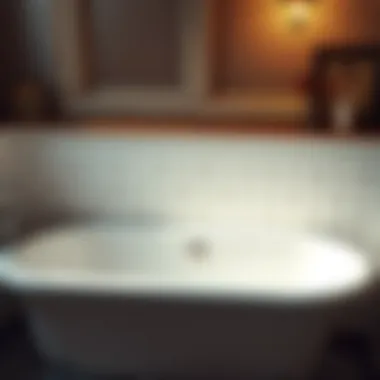
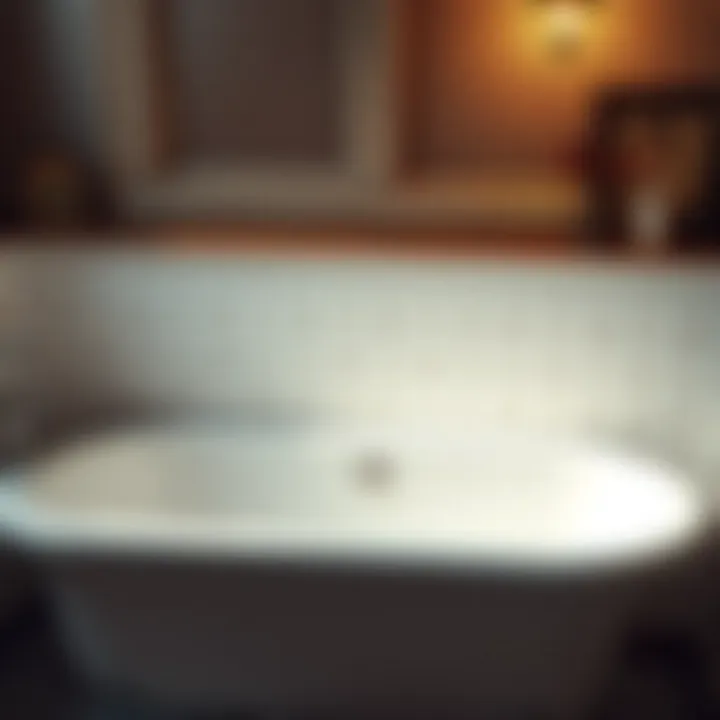
- Key characteristic: Makes your cleaning routine efficient and effective by significantly cutting down on scum.
- Benefits: A good soap reduces required scrubbing effort and enhances the pleasantness of the bathing experience.
- Unique feature: Quality soaps frequently incorporate natural ingredients that are kinder to both your skin and the bathtub, reinforcing a cycle of cleanliness without harmful chemicals.
For lasting results, consistency is key. Implementing these strategies not only preserves the look of your bathtub but fortifies its longevity, ensuring that it remains a centerpiece in your home's bathing sanctuary.
When to Seek Professional Help
Maintaining a clean and bright bathtub can sometimes feel like a Herculean task, especially with the wear and tear that comes with everyday use. When faced with persistent stains or damage beyond standard cleaning, it may be time to consider professional help. Understanding when to call in the experts can save you time, effort, and, ultimately, restore your bathtub to its former glory.
Assessing Damage Levels
Before reaching for the phone, it’s wise to evaluate the situation yourself. Take a close look at the damaged areas:
- Cracks or Chips: Small imperfections can often be fixed with DIY solutions, but larger cracks may require specialized repair techniques. If you notice water accumulating in cracks, this could lead to more significant issues down the line.
- Stains that Won't Budge: Stubborn stains from rust or hard water can sometimes be tackled with commercial products. However, if those fail, a professional cleaner has tools and methods that can penetrate deeper into the surface material.
- Loss of Shine: If the glossy finish of your bathtub has dulled over time, it might not be possible to restore it to a like-new state without professional refinishing. This process may involve sanding down the surface and applying a new layer of finish.
Take your time to assess these factors, and don't hesitate to document your findings with photos. Clear visual evidence can help you communicate better with the professionals you may choose to consult.
Specialized Products for Restoration
When tackling bathtub restoration, professionals often utilize specific products that aren't available at your average grocery store. These specialized solutions can include:
- Epoxy Resins: Used for filling in cracks and sealing chips, creating a seamless blend with the original material. This can help in prolonging the lifespan of your bathtub while restoring its appearance.
- Professional-Grade Cleaners: These cleaners are formulated to tackle the toughest stains, unlike their store-bought counterparts. For instance, products containing oxalic acid can effectively eliminate rust stains, while others may target soap scum and hard water deposits specifically.
- Sealers and Finishing Coats: After restoration, a professional may apply a protective seal that not only enhances the lustrous finish but also makes future cleaning easier. These coatings can act as a barrier against grime, keeping your bathtub looking newer for longer.
To sum it up, while DIY methods have their place, knowing when to bring in the experts can be a game changer in maintaining the cleanliness and aesthetics of your bathtub. Sometimes the investment in professional help pays off, ensuring you’ll have a sparkling bathing space that is not just functional but visually appealing as well.
Eco-Friendly Alternatives for Bathtub Maintenance
In today's environmentally conscious world, choosing eco-friendly alternatives for bathtub maintenance isn't just wise; it's essential. As homeowners and housewives look for ways to maintain their living spaces, the emphasis on sustainable cleaning solutions has grown. It’s about more than just having a shiny bathtub; it’s also about minimizing our impact on the planet. Eco-friendly cleaners are typically made from natural ingredients that are less harsh on our skin and respiratory system. Moreover, they often come without the harsh chemicals found in many commercial products, making them safer for children and pets.
Benefits of Eco-Friendly Cleaning
Adopting eco-friendly alternatives has several advantages:
- Healthier Home Environment: Natural cleaners help reduce indoor air pollution, ensuring a safer environment for you and your family.
- Reduced Chemical Exposure: By cutting down on potent chemical cleaners, you lessen the risk of skin irritations and allergic reactions.
- Sustainable Practices: Eco-friendly options promote environmental sustainability, as many come in biodegradable packaging and use renewable resources.
It's crucial to remember, however, that just because a product is labeled eco-friendly, it doesn't mean it's effective. Therefore, understanding how to leverage these alternatives properly can lead to cleaner and brighter bathtubs without the downsides.
Plant-Based Cleaners
When considering plant-based cleaners, it’s essential to know what you’re actually getting. These products harness the power of natural ingredients such as vinegar, baking soda, and essential oils to tackle tough stains and build-up in your bathtub. For instance, vinegar has acetic acid in it, which is excellent for breaking down mineral deposits.
Key Characteristics of Plant-Based Cleaners:
- Non-toxic: They contain no dangerous chemicals that can harm you or your family.
- Biodegradable: Most plant-based cleaners will break down naturally, reducing waste in landfills.
- Versatile: Such cleansers can often be used for multiple cleaning tasks beyond just the bathtub, making them cost-effective.
Plant-based cleaners can be easily found in health stores or online. However, you may find making them at home gives you better control over the ingredients.
DIY Eco-Cleaning Agents
Creating your own eco-cleaning agents is not only budget-friendly but allows personalization based on your cleaning needs. Here are a few popular DIY solutions for bathtub maintenance:
- Vinegar and Baking Soda Paste:
Mix half a cup of baking soda with a quarter cup of vinegar to create a thick paste. Apply the paste to the stained areas, let it sit for about 30 minutes, then scrub lightly before rinsing. This combination is fantastic for tackling soap scum and hard water stains. - Lemon Juice and Salt Scrub:
Combine the juice from one lemon with a quarter cup of salt. This mixture not only smells fresh but acts as a mild abrasive that lifts stains. Rub it on stubborn areas and rinse thoroughly for a sparkling clean finish. - Hydrogen Peroxide Solution:
Using a diluted solution of hydrogen peroxide (mix one part hydrogen peroxide with two parts water) can work wonders on light stains while acting as a disinfectant. Simply spray it onto the surface, allow it to sit for a few minutes, and wipe clean.
*Utilizing DIY eco-cleaning agents not only promotes sustainability but also gives you a sense of achievement as you maintain your home.
To ensure the effectiveness of these DIY solutions, regular maintenance is key. By incorporating these natural cleaning agents into your cleaning routine, you’ll not only extend the life of your bathtub but also contribute positively to the environment.
Finale
In the journey towards achieving a bright and inviting bathtub, it’s clear that the task extends far beyond mere surface cleaning. The importance of maintaining a clean bathtub lies not just in aesthetics but also in ensuring a hygienic and pleasant bathing environment for you and your family. A clean bathtub shields against health risks, promotes relaxation, and can even be a cornerstone of your home's overall atmosphere.
To encapsulate the key points discussed, let’s highlight some essential strategies. First, understanding the different materials (like acrylic, fiberglass, and porcelain) can guide the cleaning products you choose, avoiding any potential harm. Recognizing the common types of stains—from hard water marks to the stubborn rust spots—sets the groundwork for tailored cleaning techniques.
Moreover, incorporating eco-friendly solutions into your cleaning routine isn't merely a trend; it's a thoughtful choice that benefits both your environment and your health. As we touched upon natural remedies and DIY alternatives, taking this route can mitigate harsh chemicals and support sustainable living practices.
When faced with persistent stains or deeper issues, knowing when to seek professional help becomes crucial. They have the expertise to effectively restore your bathtub to its former glory without incurring damage that could arise from misguided DIY attempts.
As a part of long-term maintenance, the importance of a regular cleaning schedule cannot be overstated. Establishing a habit not only keeps your bathtub looking spectacular but also extends its lifespan, saving you money in the long run.
In closing, achieving a whiter bathtub is not simply about removing stains or achieving a pristine finish; it’s an ongoing commitment to care and attention. By utilizing the insights and techniques outlined in this article, not only can you maintain a shining bathtub, you can also foster a soothing retreat that enhances your daily life.



